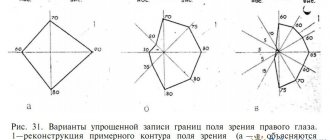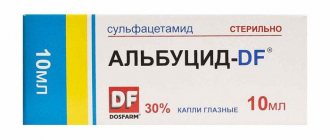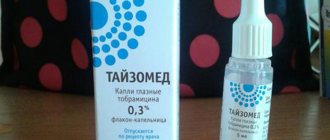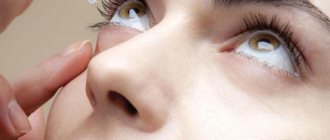Pharmachologic effect:
The medical product Khilozar-Komod ophthalmic moisturizing solution is a combination of an aqueous solution of sodium hyaluronate and dexpanthenol (provitamin B5). This is a sterile solution that does not contain preservatives, in the original container (KOMOD® system). The hyaluronic acid (in the form of sodium salt) included in the Hilozar-Komod solution is a natural substance. Sodium hyaluronate is a physiological polysaccharide compound found both in the tissues of the eye and in other tissues and fluids of the human body.
A special physicochemical property of sodium hyaluronate molecules is their pronounced ability to bind water molecules. An aqueous solution of sodium hyaluronate has the necessary viscosity and high adhesive properties in relation to the anterior surface of the eye, due to which the Khilozar-Komod solution forms a uniform precorneal tear film that persists for a long time, which is not washed off when blinking and does not cause a decrease in visual acuity. Thus, the HILOZAR-KOMOD® solution can be used throughout the day. Dexapanthenol (provitamin B5), which is part of the Hilozar-Komod solution, effectively supports the moisturizing properties of sodium hyaluronate, as it also has a high ability to bind water.
The use of Hilozar-Komod solution brings quick relief from eye irritation, helps relieve fatigue, and maintains healthy eyes. The Hilozar-Komod solution makes wearing hard or soft contact lenses more comfortable, while the Hilozar-Komod solution does not deposit on the surface of the lenses.
Constant and sufficient moistening of the surface of the eye with the Hilozar-Komod solution contributes to the normal physiological course and thereby accelerates the healing of injuries and wounds of the eye after injuries and surgical interventions.
The Hilozar-Komod solution is placed in the original “KOMOD” container, which is a complex system of reservoirs and valves that guarantees the absence of air penetration from the outside and ensures the extraction of drops of the same size, regardless of the degree of force applied. The metal parts and container valves in contact with the Khilozar-Komod solution are partially coated with a thin layer of silver, which, together with the absolute tightness of the system, ensures the sterility of the Khilozar-Komod solution in the absence of preservatives.
This eliminates possible undesirable effects of preservatives on eye tissue and ensures good tolerability of the Hilozar-Komod solution even with long-term use.
Hilokomod and hilozar chest of drawers, what is the difference
Dry eyes are stressful for ocular surface cells. If there is a lack of fluid, they are damaged and may die due to poor nutrition and insufficient oxygen supply.
Special moisturizing drops will help prevent this. It is difficult to select them, so a comparative analysis is carried out between drugs that are identical at first glance.
Khilozar-Komod
The drug is keratoprotective and moisturizing. This is a sterile liquid based on sodium hyaluronate and dexpanthenol. Does not contain preservatives, is equipped with the “Komod” system, which allows dosing and not using in excess quantities.
It has the necessary viscosity and high adhesion to the mucosa. Khilozar-Komod creates a film on the surface of the outer shell that lasts for a long period.
Hilo-Chest
The medicine is prescribed for dry keratoconjunctivitis, discomfort when using contact vision correction and after eye surgery.
Hilo-Komod creates a moisturizing film, a unique system guarantees sterility. Does not contain preservatives and phosphates.
Non-surgical eye treatment in 1 month.
Comparison of drugs
Both are produced by the same manufacturer and contain the same active ingredients. Similar in action and application.
The difference between them is in the excipients. Hilozar-Komod contains sodium hydrogen phosphate dihydrate and dexpanthenol, while Hilo-Komod contains citric acid and sodium citrate. The first contains practically no preservatives, so it costs more. The first medicine cannot be used 12 weeks after opening the container, the second can be used up to 6 months.
What's better
Both medications work the same way. Eliminate dryness and fight redness. Removes the sensation of a foreign body in the eye. The eyes get tired more slowly.
Simultaneous use of Hilozar-Komod and Hilo-Komod
There are no restrictions on the duration of use of moisturizing solutions for the eyes. They can be used as much as needed to relieve discomfort.
Both medications cannot be used at the same time. There are no official data on cases of overdose of hyaluronic acid. However, doctors do not recommend using them at the same time, as this may cause corresponding side effects.
Poor vision significantly worsens the quality of life and makes it impossible to see the world as it is.
Not to mention the progression of pathologies and complete blindness.
MNTK "Eye Microsurgery" published an article on non-surgical restoration of vision up to 90%, this became possible thanks to.
What else to read
I have been using Hilo-Komod for a long time and also have experience using Hilozar. I don’t quite understand what “harmful substances” the article is talking about. More like the author's speculation. I carefully studied the instructions for both drugs before use.
The whole difference in composition lies in the presence of an additional component in Khilozar - dexapanthenol. And there are no phosphates (sodium hydrogen phosphate in particular) in any of them - this, by the way, is one of the advantages, which is why I chose them.
And citric acid, sodium citrate and sorbitol are contained in both.
So the author needed to study the instructions more carefully before writing the article.
The article was written by an amateur who does not have an ounce of knowledge about both drugs. And certainly not a person with a medical education. Both solutions are completely free of harmful substances and preservatives; you just need to read the instructions for use and have at least the slightest idea about the origin of these substances.
Baryshnikova Daria Andreevna
Head of the ophthalmology department, ophthalmologist at the multidisciplinary clinic Sante Clinic, Moscow. Member of the Association of Interdisciplinary Medicine.
The feeling of sand in the eyes, burning and itching, redness of the eyes - every person has experienced it at least once. But for many people, the problem of dry eyes has become a part of life.
Dry eye syndrome is now diagnosed very often, regardless of age, field of activity and other criteria.
Not everyone turns to an ophthalmologist for an examination and selection of treatment; many more people simply turn to the nearest pharmacy with a request “recommend some eye drops” or buying a drug that is widely advertised.
In this article I will talk about tear substitutes - what are the differences, what drugs can be used with contact lenses, what are the advantages and disadvantages of certain drops. Also, for your information, next to the names the average price in pharmacies is indicated.
Since the tear film consists of 3 layers: lipid (on the surface), aqueous and mucin, the drugs act on different layers. Only an ophthalmologist can diagnose which layer of the tear film is pathological, so if possible, consult a specialist for a thorough examination and selection of a drug.
Ophthalmologists prefer drugs that do not contain the preservative benzalkonium chloride. With long-term use of this substance, dry eye syndrome worsens and the lipid layer in the tear film is destroyed.
This preservative can also be deposited on contact lenses, which leads to loss of transparency, so if you have contact lenses on your eyes, this drug cannot drip.
Lenses can be used no earlier than 20-30 minutes after instillation of these drops.
Source: https://sustavo.ru/info/hilokomod-i-hilozar-komod-v-chem-raznica/
Indications for use:
- for additional moisturizing, lubrication and protection of the anterior surface of the eye (cornea and conjunctiva), eliminating discomfort from a feeling of “dryness”, a feeling of a foreign body, burning in the eyes, including those arising under the influence of wearing soft and hard contact lenses, climatic factors, intense visual load;
- for moisturizing, lubricating and accelerating healing of the anterior surface of the eye after ophthalmic surgery, as well as for damage and trauma to the cornea.
Directions for use and dosage:
It is recommended to instill Hilozar-Komod solution 1 drop 3 times a day into the conjunctival sac of each eye. If necessary, the Hilozar-Komod solution can be instilled more often. The frequency of instillation of the solution is set individually depending on the sensations and according to the recommendations of an ophthalmologist or contact lens specialist. If a patient instills Khilozar-Komod solution very often (for example, more than 10 times a day), he should consult with an ophthalmologist.
There are no restrictions on the duration of use of the Hilozar-Komod solution. If, after using the Hilozar-Komod solution for several days, the complaints or discomfort persist, the patient should consult a doctor.
The KOMOD® system contains and allows you to extract 10 ml of Khilozar-Komod solution, which corresponds to approximately 300 drops of solution.
After completely using the contents, you should purchase a new filled container with Hilozar-Komod solution, since the system is not intended for reuse.
Instructions for use
Before instilling drops, you must first unscrew the colored cap from the dropper bottle. When performing the procedure for the first time, it is recommended to turn the bottle of medicine over so that the dispenser is at the bottom, and, pressing rhythmically on the base, remove one drop. Thanks to such manipulations, the bottle will be prepared for the first use.
Before administering the drug, the patient is recommended to slightly tilt his head back and pull down the lower eyelid. After this, the eyes are carefully closed to distribute the medicine evenly. Do not touch the tip of the dropper to the surface of the organs of vision , skin, or other objects. It is not advisable to touch it with your hands. When the procedure for introducing drops is completed, the dropper bottle is closed with a colored cap.
It has been noted that the eye drug Khilozar, when used correctly and regularly, provides more comfortable use of contact lenses. From the instructions you can learn about all the nuances of using the medicine in such cases. It is noteworthy that you can apply the drug without removing the lenses from your eyes, or you can simply treat the lenses with the solution before putting them on.
Dosage and duration of use
The principle of using eye drops is to instill them into the conjunctival sac. The application regimen involves introducing only one drop into the eye. In some cases, an increase in dosage may be required. In the absence of contraindications , the drug can be used for a long time.
When determining the optimal dosage, it is necessary to take into account not only the patient’s personal feelings, but also the recommendations of an ophthalmologist or eye lens consultant. If drops are instilled 10 times a day, you should immediately see a doctor. Those patients who are bothered by a feeling of discomfort .
A bottle with used medicine cannot be refilled. The patient is recommended to purchase a new container with drops.











